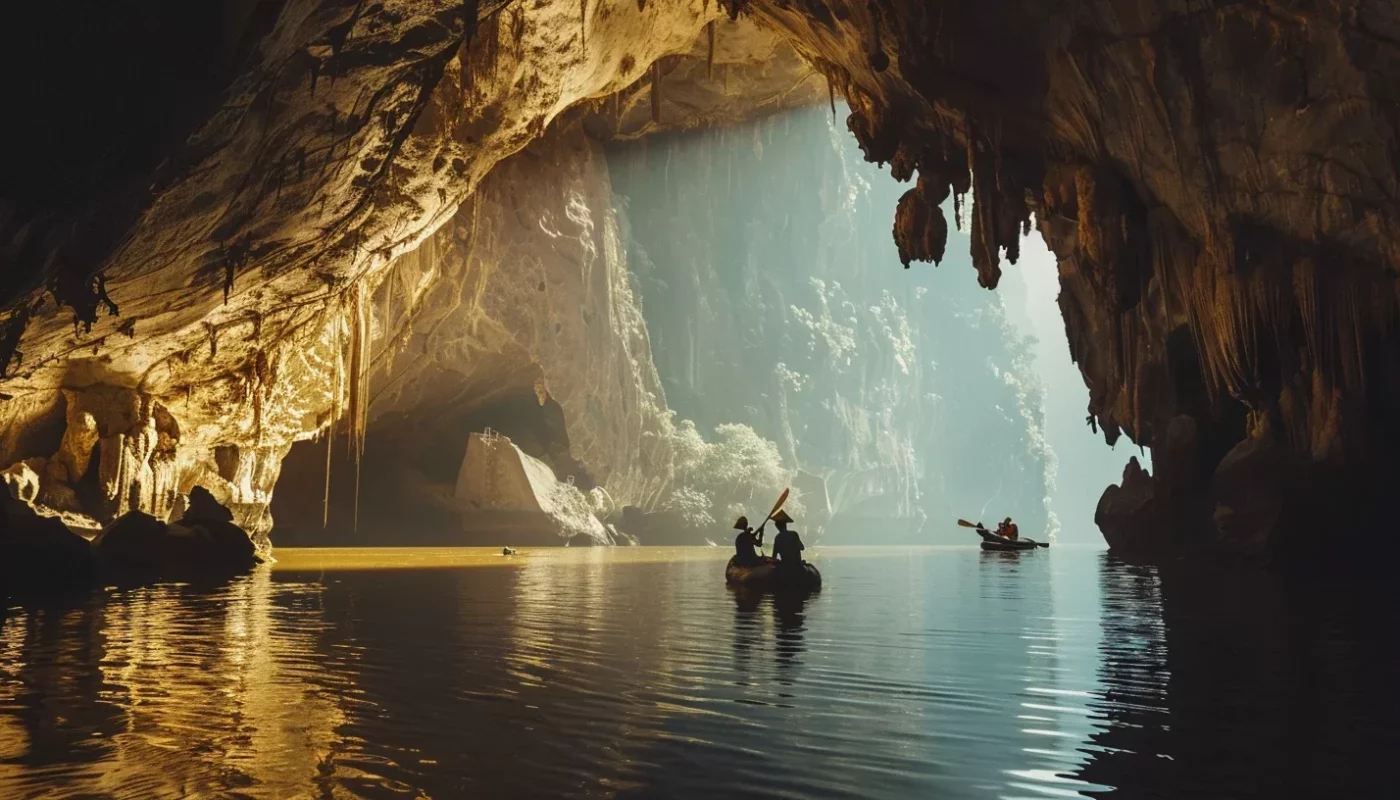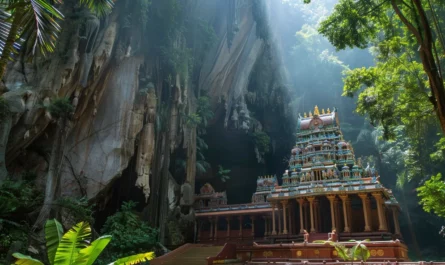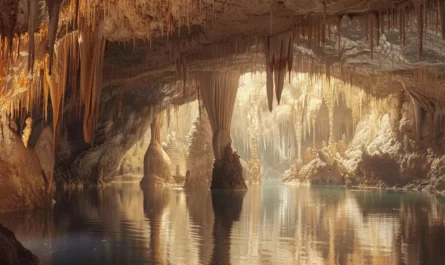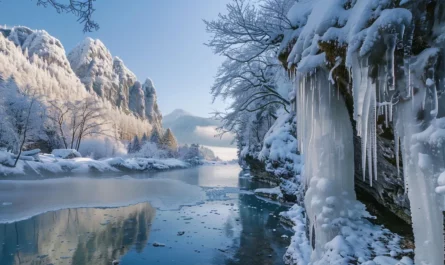Located in Vietnam’s Quang Binh province, Hang Sơn Đoòng is the biggest cave by volume. Ho Khanh found it in 1990. It was later measured by the British-Vietnam Cave Expedition Team in 2009. It spans a massive 38.5 million cubic meters. This makes it a major natural wonder and a top choice for explorers and lovers of nature.
Huge and awe-inspiring, Hang Sơn Đoòng is unlike any other cave. It boasts massive stalactites, a hidden underground river, and a unique ancient rainforest. Found deep in the Vietnam jungle, it’s a dream for any adventure lover.
Preserving Hang Sơn Đoòng is key. It shows why we must protect such amazing places for our future. To truly see its beauty, dive into Hang Sơn Đoòng. Discover the stunning grandeur of the world’s largest cave.
The Origin and Name of Hang Sơn Đoòng
The largest cave in the world is named Hang Sơn Đoòng. It was found by Ho Khanh. “Son Doong” comes from the word for mountain and the name of a valley where people live. This shows it’s in a mountain and has a river inside.
In 1990, Ho Khanh made an incredible find. He found Hang Sơn Đoòng. This cave has since shown the world a wonder of Vietnam’s nature and history.
“Son Doong” reflects the cave’s beauty. It connects the grand mountains with the valley home of the Bru Van Kieu people. It shows the true wonder of nature and the cave’s importance.”
Exploring deeper in Hang Sơn Đoòng, we see its name’s meaning. It’s tied to the beauty and uniqueness of Vietnam’s natural treasures.
Key Points:
- Hang Sơn Đoòng was named by its discoverer, Ho Khanh.
- The name “Son Doong” combines “Son” (mountain) and “Doong” (the valley of the Bru Van Kieu).
Unique Features of Hang Sơn Đoòng
Hang Sơn Đoòng is the world’s biggest known cave. It stretches nearly 9 kilometers, far bigger than other caves. Its 38.5 million cubic meters beat the old record by five times. This makes it the largest cave on Earth.
The cave is home to giant stalactites. Some of these tower over 80 meters. They are a wonder, showing the beauty of nature over millions of years.
In its depths, Hang Sơn Đoòng hides a prehistoric rainforest, untouched by the sun. This world within a cave is full of life. Green plants cover the floor and ancient trees stretch to the cave ceiling. It shows how life can thrive in surprising places.
A hidden river also flows through the cave. This river remains a mystery, waiting for explorers to find its secrets. It’s an invitation to discover the unseen beauty of the cave.
Explorers inside Hang Sơn Đoòng discover a world unlike any other. They find an underground river, huge stalactites, and a prehistoric forest. These create a unique experience. It reminds us of the world’s hidden marvels, encouraging us to protect them for the future.
Hope and Vision Passage
The Hope and Vision Passage in Hang Sơn Đoòng is truly special. It shows off its size and beauty in an incredible way. This area is awe-inspiring, stretching over a long distance.
Named for its grand view, the Hope and Vision Passage inspires all who see it. The light from far Doline 1 helps show its vastness. It’s located 1.5 kilometers away but still lights up the path.
“The Hope and Vision Passage show the power and beauty of nature. It’s grand and full of stunning formations.”
The Hope and Vision Passage can hold a 40-story skyscraper or a Boeing 747. Walking through, you’ll see amazing rock formations and huge stalagmites. It feels like a place from another world.
Tallest Stalagmite in the World
Inside the Hope and Vision Passage, you’ll find the world’s tallest stalagmite. It reaches about 80 meters high. This natural wonder is truly a sight to see.
This huge stalagmite is a symbol of time and nature’s art. Its size and detail draw in visitors, marking their journey forever.
Hang Sơn Đoòng – Key Facts
| Feature | Description |
|---|---|
| Location | Quang Binh province, Vietnam |
| Volume | Largest cave in the world by volume – 38.5 million cubic meters |
| Discovery | Discovered by Ho Khanh in 1990 |
| Unique Features | Giant stalactites, underground river, primaeval rainforest |
| Hope and Vision Passage | Key section with great size and the world’s tallest stalagmite |
The Hope and Vision Passage is a must-see part of Hang Sơn Đoòng. It showcases nature’s power and beauty below the surface. Its size, beauty, and formations are amazing.
See the incredible beauty of the Hope and Vision Passage. Step into a world where nature’s artistry and scale are unmatched.
The Underground River in Hang Sơn Đoòng
Hang Sơn Đoòng is known for its underground river, formed by two caves’ water mixing. As you journey, you’ll cross knee-deep rivers. This journey takes you to Hope and Vision Passage, known for its beauty.
Walking through water makes this trip exciting. Waterfalls also make the scene spectacular. Sometimes there’s mist in the cave, making it mysterious.
This river shapes the cave and its stunning look. Water has cut through the rock for years. This created the beautiful formations we see today.
You will end this part of the journey at Doline 1, about 4.5 km inside the cave. Here, the underground river vanishes. It shows how many secrets Hang Sơn Đoòng holds.
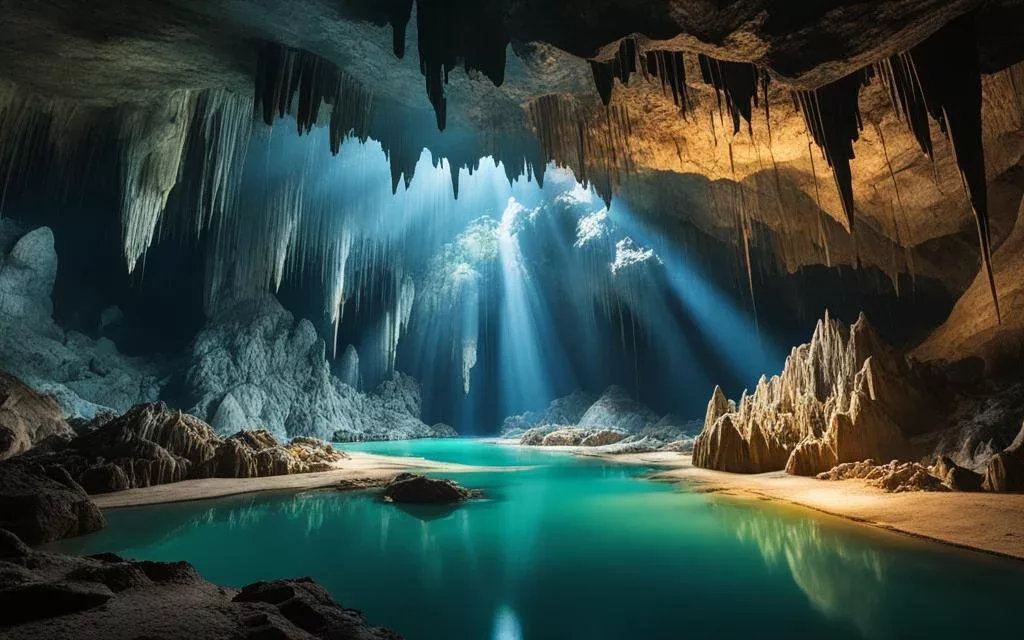
Conservation Efforts
Hang Sơn Đoòng is becoming more popular. There’s an important need to protect it. By limiting visitors, we can keep this wonder safe for the future.
To help, it’s crucial to follow guidelines and support conservation. This ensures Hang Sơn Đoòng remains a marvel for all to see.
Fossil Passage
The Fossil Passage in Hang Sơn Đoòng is fascinating. It’s found 40 meters below the campsite. As you go through, you’ll see ancient corals turned to stone. They’re millions of years old. This shows the amazing beauty and age of the cave.
There’s a surprise in the Fossil Passage – an underground lake. This calm, clear lake is a perfect spot to relax. The water is always cool, between 17 to 20 degrees Celsius.
“The Fossil Passage is a true marvel of time frozen in stone. The intricate corals preserved within the cave walls transport you back to a prehistoric era, immersing you in the wonders of Earth’s ancient past.”
Exploring the Fossil Passage is a journey you won’t forget. You’ll learn about the cave’s deep history. Cooling off in the underground lake is a nice break. It’s a reminder to protect our natural world. Keeping places like Hang Sơn Đoòng safe is important. This way, others can also see its beauty in the years to come.
Doline 1 – Watch out for Dinosaurs
Doline 1, also called the giant skylight, is a fallen roof of the world’s biggest cave, Hang Sơn Đoòng. As explorers go deeper, they see the amazing Doline 1. It drops 449 meters, from the top cliffs to the river below, offering a breathtaking view.
“We were in complete awe when we first witnessed Doline 1,” said one explorer. “The sight of the giant skylight opening up to the outside world was truly breathtaking.”
Doline 1 is 125 meters wide, making it one of the Son Doong system’s largest spots. Found about 3 kilometers from the entrance, it shows the beauty of what’s inside.
Between January and March, sunlight reaches into the cave, showing off a magical view. This event turns the dark into a place of light, just like in Avatar.
The grandness of Doline 1 proves the wonders of Hang Sơn Đoòng. It lets sunlight in, showing off the huge size and ancient rocks of the cave.
The History and Significance of Doline 1
Doline 1 shows nature’s strength over millions of years. The fallen roof uncovers the secret beauties of Hang Sơn Đoòng.
Many are fascinated by Doline 1’s unique rocks, which are over 350 million years old. The high purity limestone is perfect for studying Earth’s past.
| Depth | Width | Location |
|---|---|---|
| 449 meters | 125 meters | About 3 km from the entrance |
Doline 1 highlights Hang Sơn Đoòng’s geology and helps protect its ecosystems. Sunlight at the entrance feeds the plants and animals below, aiding conservation.
Hang Sơn Đoòng with Doline 1 is a top spot for adventure and nature lovers. Its combination of the giant skylight and special scenes creates a memory that lasts.
Doline 2 – Garden of Edam
Doline 2, or the Garden of Edam, is stunning. It’s about 1 kilometer away from Doline 1 in Hang Sơn Đoòng. Here, you find an ancient forest under huge limestone mountains.
This forest is lit by natural sunlight from the doline above. It helps a variety of plants grow. As you walk through, you’ll see ferns, begonias, and big trees. It’s like walking in a dream with all the green around you.
“Walking through the Garden of Edam feels like stepping into another world. The sight of towering trees and vibrant foliage against the subterranean backdrop is truly awe-inspiring.” – Nature enthusiast
When you explore this forest, you’ll find a special campsite. It’s a great chance to really experience the beauty of Hang Sơn Đoòng.
Conservation Efforts
We must keep places like Doline 2 and its forest safe. Efforts to protect Hang Sơn Đoòng are very important. This way, everyone can enjoy them for years to come.
Cave Pearls
Hang Sơn Đoòng is the biggest cave on Earth. It is famous for its huge size and amazing underground features. The cave is also known for its Cave Pearls. These pearls are made when water drops, carrying calcite carbonate, land on the walls and ceilings. They make the cave even more beautiful.
The Cave Pearls vary in size and shape. You can find small pearls and big clusters. They form slowly as calcite crystals build up. The water drips or seeps through cracks, laying down layers of calcite.
Illuminate them, and they shine brightly. The pearls’ smooth surfaces reflect light in a stunning way. This beauty catches everyone’s eye.
“The Cave Pearls in Hang Sơn Đoòng are truly a sight to behold. They have an ethereal quality to them, especially when the water flows through, giving them a luminescent glow,” says Dr. Emily Johnson, a renowned cave geologist.
Cave Pearls look amazing in the cave. But they quickly lose their shine outside. The dry air makes the calcite carbonate formations dull.
Conservation Efforts
As Hang Sơn Đoòng gets more popular, we must protect it. This means taking care of the Cave Pearls and the whole cave. We need to limit visitors, reduce foot traffic, and keep the cave in its natural state.
Teaching people about the cave’s fragility can help. Everyone needs to feel responsible. This way, we keep Hang Sơn Đoòng and its treasures safe for those who come after us.

Passchendaele Passage and the Great Wall of Vietnam
Passchendaele Passage is named after a World War I battle. It’s a 600-meter-long path in Hang Sơn Đoòng that’s very hard to walk. Explorers must be very tough and determined to go through this big cave.
Walking through Hang Sơn Đoòng is an adventure. Those exploring go through muddy places, which often fill with water and turn into a pretty green lake. Sometimes, visitors have to use boats to get through.
At the end of the cave, discover the Great Wall of Vietnam. It’s a huge rock formation that makes the cave even more stunning. The Great Wall shows us how powerful and beautiful nature can be.
Conclusion
Hang Sơn Đoòng is the biggest cave on Earth, stunning all who visit. It was found in 1991 but not fully explored until 2009. This cave is truly massive, able to fit 40-floor buildings from New York in its space.
Its features, such as huge stalactites and an underground river, are one-of-a-kind. It also has a rainforest inside, creating a magical place for those who visit.
The cave is also important for the nearby people, creating 500 jobs with its tourism. However, the pandemic hurt this, with a 90% drop in visitors. This has seriously affected the local community.
Protecting Hang Sơn Đoòng is critical for the ecosystem. Vietnam allows just one tour company to operate here. This is to prevent damage to the environment. But, there are still threats from poaching and logging.
There’s also a concern about a cable car being built to another cave nearby. This has highlighted the need for sustainable tourism. Visiting this cave not only brings adventure. It also shows why we must care for our planet’s treasures.
Discover more about the wonders of Hang Sơn Đoòng

